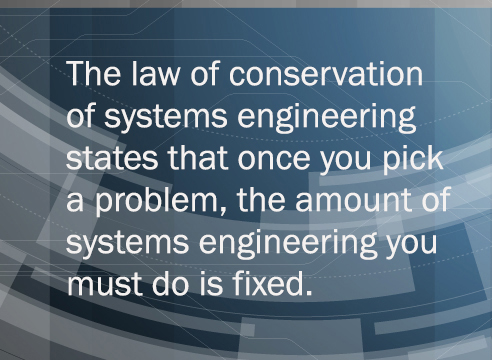This is Part II in a series of posts about the history of Vitech. Part I recounts the company’s beginnings, in 1992. Part III charts the growth of Vitech as the practice of systems engineering itself expands. In Part IV, Vitech enters the new millennium, and the redesign of a classic infantry carrier vehicle gets a boost. In Part V, Vitech contributes to thought leadership for the developing discipline of systems engineering. Part VI concludes the history with two of Vitech’s executives noting the idiosyncrasies that evolved from the genesis of systems engineering in specific fields and encouraging us to expand our thinking on how systems engineering can help meet the challenges of the 21st century.
A successful company may be known for its founder, but there are often other key people who help the enterprise grow to significance and to whom it owes much. Jim Long is one such person in the history of Vitech. What makes his story so interesting is that he became a systems engineer before the profession really had a name.
To chart the course of Jim’s outsize contribution to Vitech, we need to start in the summer of 1992, when his son David established Vitech on the strength of his initial software product and systems engineering tool, CORE. When it came time for David’s first hire, he didn’t have to look far for talent. In February of 1993, he signed on his father as president.
Jim had been born in the small town of Hoopeston, in rural east central Illinois, where his father was a tenant farmer. Through application and industry, he grew up to be the first in his family to go to college. He attended General Motors Institute in Flint, Michigan, which was, during the middle part of the 20th century, an in-house training venture run by GM that followed an innovative curricula: Work and school were inter-mixed in 6-week rotations. It was a structure that matched the young man’s sensibilities; he thrived on the combination of theoretical learning and practical application.
Jim went on to work at TRW in the late 1960s and early 70s, where he served as project lead for a group that worked on the Distributed Computing Design Software and pioneered the practice of systems engineering. Because TRW was a leader in its day in the production of aerospace, automotive, and defense-related products, it was a great place to be if you were developing the practice of systems engineering.
Jim had inspired in his son a way of thinking that David later realized was systems thinking. “The way he taught me to see the world was all systems concepts,” David recalled. “Before I knew what systems engineering was, I knew I wanted to be a systems engineer.”
As the original systems engineer in the family, Jim was a logical choice for David to hire.
“Jim was the ‘outside’ guy, doing consulting and sales,” David said. “I was the ‘inside’ guy, working on developing the software.”
Jim was an inspiration not only for his deep knowledge of systems engineering, but also for the way he lived his life. By all accounts, Jim was a quintessential Midwesterner, possessed of a strong work ethic and good, solid values. “No one in the industry had a bad thing to say about him,” according to David.
Zane Scott, vice president for professional services at Vitech, concurred. “You couldn’t know Jim for more than about five minutes before you liked him. He was tremendously credible. You trusted him, and you liked him.”
One thing Jim taught David was “the law of conservation of systems engineering.” It states that once you pick a problem, the amount of systems engineering you must do is fixed. The question then becomes, “Should you do the systems engineering up front? Or at the integration and testing point?”

But it’s a trick question. Most people do systems engineering at the integration and test phase, when they see that things aren’t coming together well. However, the cost incurred by inserting systems engineering at this late stage is at least three times that of implementing it in the design phase. This is simply a corollary of famed software engineer Barry Boehm’s adage, “The earlier you catch an error in software, the cheaper it is.”
Sadly, the famous engineering saying is borne out all too often: “Never enough time to do it right, but always enough time to do it over.” By which is meant, “We don’t take time to do it right the first time. . .”
Jim Long was an advocate of doing things right the first time—taking the time to think things through before implementation. “His contributions, not only to our bottom line, but also to how we did things, are immeasurable, making the systems perspective a defining characteristic of how we build and operate Vitech rather than something we simply advocate,” said David.
One of Jim’s seminal contributions was the systems concept of STRATA™—a way of thinking through a problem using a layered approach. At each level of design, each domain of systems engineering—requirements, behavior, architecture, and validation and verification—receives no more detail in its delineation than is necessary for that level. This contrasts with the classic waterfall approach in which requirements were worked to completion before beginning to think about behavior or architecture. Jim realized that requirements, behavior, and architecture were coupled, and that top-level behavior and architectural decisions impact second-level requirements.
Using a waterfall approach, one can fall prey to the temptation of developing one facet of a problem all the way to a granular level, which often results in unnecessary or inappropriate work which must then be reversed later based upon insights gained from the behavior and physical architecture. The layered approach is also far more resilient to changes in schedule and funding, always providing a cohesive systems design that is progressively elaborated with additional detail as time and money permit.
With STRATA, by a judicious apportioning of problem capture and analysis, a solution is developed layer by layer. At each step of the way, the picture of a solution emerges in greater and greater detail across the entire structure.
Jim turned over the reins of Vitech to David in 2005 so that he could focus on his role as Chief Methodologist, continuing to advocate for systems engineering while teaching and mentoring project teams to help them advance their systems engineering capabilities. The methodology Jim advanced was not born in the lab—it was born from practical experience on the most complex problems. Jim spent his career continuing to evolve and advance the methodology based upon new problems, new experiences, internal ideas, and industry innovations. To him, systems engineering was more about a mindset and approach than a series of steps in a defined process. It was also inherently about the application and value delivered to the ultimate customer.
David acknowledges the enormous debt he owes his father. “I had the pleasure of working with him for 18 years,” he said. “He sacrificed a classic father-son relationship so that we could work together, and because of that I had the opportunity to learn from one of the masters of our practice. And I wasn’t the only one learning from him. I am constantly reminded by senior leaders across systems engineering who sat in a class or worked on a project led by Jim. He left his mark on systems engineering, and every day I strive to continue the groundbreaking work he began at TRW.”
For his contributions to the practice of systems engineering, Jim was made a fellow of the International Council of Systems Engineering and named an “Eminent Engineer” of Tau Beta Phi, the engineering honor society. He passed away in 2010 at the age of 74.






A small addition: Jim received an MS in Aeronautics and Astronautics from Purdue in 1965.
Thanks, Bob.
Having competed with and worked with Jim Long since 1976 I would like to emphasize that Jim was highly effective in harmonizing a system composed of people even those who brought conflicting ideas and values to the project.
Thanks, Jack. That’s such a valuable skill to have.
Thanks Jack. Jim had a great way of connecting with people regardless of their background, position, or perspective. He respected people, and they respected him which certainly made a difference as he brought together stakeholders and teams to deliver results.